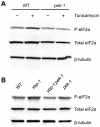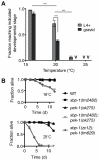Physiological IRE-1-XBP-1 and PEK-1 signaling in Caenorhabditis elegans larval development and immunity
- PMID: 22125500
- PMCID: PMC3219621
- DOI: 10.1371/journal.pgen.1002391
Physiological IRE-1-XBP-1 and PEK-1 signaling in Caenorhabditis elegans larval development and immunity
Abstract
Endoplasmic reticulum (ER) stress activates the Unfolded Protein Response, a compensatory signaling response that is mediated by the IRE-1, PERK/PEK-1, and ATF-6 pathways in metazoans. Genetic studies have implicated roles for UPR signaling in animal development and disease, but the function of the UPR under physiological conditions, in the absence of chemical agents administered to induce ER stress, is not well understood. Here, we show that in Caenorhabditis elegans XBP-1 deficiency results in constitutive ER stress, reflected by increased basal levels of IRE-1 and PEK-1 activity under physiological conditions. We define a dynamic, temperature-dependent requirement for XBP-1 and PEK-1 activities that increases with immune activation and at elevated physiological temperatures in C. elegans. Our data suggest that the negative feedback loops involving the activation of IRE-1-XBP-1 and PEK-1 pathways serve essential roles, not only at the extremes of ER stress, but also in the maintenance of ER homeostasis under physiological conditions.
Conflict of interest statement
The authors have declared that no competing interests exist.
Figures







Similar articles
-
Endoplasmic Reticulum Homeostasis Is Modulated by the Forkhead Transcription Factor FKH-9 During Infection of Caenorhabditis elegans.Genetics. 2018 Dec;210(4):1329-1337. doi: 10.1534/genetics.118.301450. Epub 2018 Oct 4. Genetics. 2018. PMID: 30287474 Free PMC article.
-
Genetic interactions due to constitutive and inducible gene regulation mediated by the unfolded protein response in C. elegans.PLoS Genet. 2005 Sep;1(3):e37. doi: 10.1371/journal.pgen.0010037. PLoS Genet. 2005. PMID: 16184190 Free PMC article.
-
PEK-1 is crucial for hormesis induced by inhibition of the IRE-1/XBP-1 pathway in the Caenorhabditis elegans mev-1 mutant.Biochem Biophys Res Commun. 2016 May 13;473(4):1052-1057. doi: 10.1016/j.bbrc.2016.04.014. Epub 2016 Apr 5. Biochem Biophys Res Commun. 2016. PMID: 27055592
-
Endoplasmic reticulum stress signaling: the microRNA connection.Am J Physiol Cell Physiol. 2013 Jun 15;304(12):C1117-26. doi: 10.1152/ajpcell.00061.2013. Epub 2013 Mar 20. Am J Physiol Cell Physiol. 2013. PMID: 23515532 Review.
-
Hypoxia signaling and resistance in C. elegans.Trends Endocrinol Metab. 2010 Jul;21(7):435-40. doi: 10.1016/j.tem.2010.02.006. Epub 2010 Mar 23. Trends Endocrinol Metab. 2010. PMID: 20335046 Review.
Cited by
-
The ire-1 ER stress-response pathway is required for normal secretory-protein metabolism in C. elegans.J Cell Sci. 2013 Sep 15;126(Pt 18):4136-46. doi: 10.1242/jcs.123000. Epub 2013 Jul 10. J Cell Sci. 2013. PMID: 23843615 Free PMC article.
-
A novel role of a lipid species, sphingosine-1-phosphate, in epithelial innate immunity.Mol Cell Biol. 2013 Feb;33(4):752-62. doi: 10.1128/MCB.01103-12. Epub 2012 Dec 10. Mol Cell Biol. 2013. PMID: 23230267 Free PMC article.
-
XBP-1 is a cell-nonautonomous regulator of stress resistance and longevity.Cell. 2013 Jun 20;153(7):1435-47. doi: 10.1016/j.cell.2013.05.042. Cell. 2013. PMID: 23791175 Free PMC article.
-
Systemic stress signalling: understanding the cell non-autonomous control of proteostasis.Nat Rev Mol Cell Biol. 2014 Mar;15(3):211-7. doi: 10.1038/nrm3752. Nat Rev Mol Cell Biol. 2014. PMID: 24556842 Free PMC article.
-
A conserved mitochondrial surveillance pathway is required for defense against Pseudomonas aeruginosa.PLoS Genet. 2017 Jun 29;13(6):e1006876. doi: 10.1371/journal.pgen.1006876. eCollection 2017 Jun. PLoS Genet. 2017. PMID: 28662060 Free PMC article.
References
-
- Mori K. Signaling pathways in the unfolded protein response: development from yeast to mammals. Journal of Biochemistry. 2009;146:743–750. - PubMed
-
- Ron D, Walter P. Signal integration in the endoplasmic reticulum unfolded protein response. Nature Reviews Molecular Cell Biology. 2007;8:519–529. - PubMed
-
- Schröder M, Kaufman RJ. The mammalian unfolded protein response. Annual Reviews in Biochemistry. 2005;74:739–789. - PubMed
-
- Calfon M, Zeng HQ, Urano F, Till JH, Hubbard SR, et al. IRE1 couples endoplasmic reticulum load to secretory capacity by processing the XBP-1 mRNA. Nature. 2002;415:92–96. - PubMed
Publication types
MeSH terms
Substances
Grants and funding
LinkOut - more resources
Full Text Sources
Research Materials

